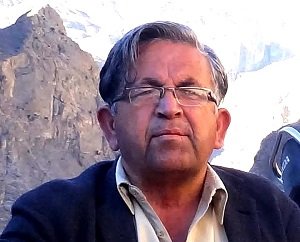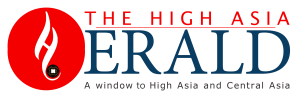As the world commemorates the 25th anniversary of International Mother Tongue Day, speakers of Xikhwor (Wakhi)—a vulnerable language of the High Asia region—are battling to preserve and promote their linguistic heritage from extinction. In this essay, I will explore the origin, historical significance, and contemporary challenges confronting the Wakhi language.
History
The Wakhi speakers — approximately 50,000–60,000–are dispersed across High Asia – Afghanistan’s Wakhan Corridor, Tajikistan’s Gorno-Badakhshan Oblast, China’s southwestern Tashkurgan County of Xinjiang, and Pakistan-administered Gilgit-Baltistan’s Hunza and Ghizer districts, as well as Broghil valley of Chitral with a growing diaspora in Europe, North America, and Middle East.
Wukhan Langar in Afghanistan’s Badakhshan Wilayat (province), stretching from the Panj Daryo (Oxus River) to the Hindu Kush peaks, is one of the oldest heartlands of the Wakhi people. Their homeland was fragmented by Colonial ‘Greate Game’ players in 19th–20th Century which severed ethnic, economic, and political ties (Badenkov 1992). Today, despite their geographic partitioned spread, Wakhi speakers remain united by a shared cultural Pamiri identity rooted in their ancient tongue.
The origin of Wakhi language
Historical records from Persian, Arabic, Chinese, Russian, and European sources attest to the Wakhan region’s prominence as an independent kingdom. These accounts highlight its strategic and cultural importance along the ancient Silk Route, where Wakhi served as a lingua franca for trade and diplomacy.
The Pamir region is widely regarded as one of the ancient homelands of the Indo-Iranian peoples (often termed Aryans in historical linguistics). From this mountainous region, migrations beginning in the second millennium BCE carried Indo-Iranian languages and culture westward to Persia (Iran), southward to the Indian Subcontinent, and eventually into Europe via later Indo-European expansions. This shared ancestry explains linguistic parallels between Wakhi, and modern Indo-European languages and grammatical features lost in other Iranian languages. These connections underscore the Pamirs’ role as a crossroads of ancient human movement and cultural exchange.
Wakhi, a Pamiri language within the modern East Iranian group, is distinct from historic Eastern Middle Iranian languages like Avestan, Sogdian, Chorasmian, Bactrian, and Khotanese Tumshuquese (Saka). Unlike these ancient tongues, modern East Iranian languages including Wakhi, are not direct descendants but share linguistic roots. Sogdian, once the lingua franca of the Silk Route, and Khotanese Saka, which shows notable affinities with Wakhi, underscore the region’s rich linguistic tapestry. Today, Wakhi persists as a living bridge to this heritage, reflecting centuries of cultural exchange along the high-altitude corridors of the Pamirs.
The Wakhi language thrives primarily in the high-altitude valleys of the Pamir Mountains, particularly the regions drained by the Oxus River (Amu Darya) and its tributaries in modern-day Gorno-Badakhshan autonomous region of Tajikistan. Historical and linguistic evidence, as noted by Odinamohd (Odina Mohammad) in his work Wakhan, suggests that Wakhi communities inhabited the upper Oxus basin as early as the second millennium BCE. Scholars link these ancient inhabitants to the cultural milieu that produced the Avesta—the sacred texts of Zoroastrianism—with geographical names in the Avestan region of Airyanem Vaejah (Land of the Aryans) corresponding to areas along the upper Oxus and Jaxartes (Syr Darya) rivers. Wakhi, thus, stands as a living relic of this ancient heritage, preserving echoes of a pivotal era in Indo-Iranian history.
Eastern Iranian languages were spoken near the Amu Darya (Oxus River) as early as the 6th–7th centuries BCE, as evidenced by linguistics (Payne 1996). While scholars like Morgenstein (1938) posit that Wakhi speakers descended from the earliest Iranian migrations into the region, direct continuity between today’s Wakhi communities and ancient Eastern Middle Iranian populations (e.g., Sogdian, Bactrian) cannot be assumed.
Centuries of sociocultural evolution, migrations, and contact with neighboring Turkic, Indic, and other Iranian groups have reshaped Wakhi identity and language. Nevertheless, Wakhi retains archaic features that link it to proto-Iranian roots, serving as a linguistic relic of the broader Indo-Iranian dispersal from Central Asia.
Oral traditions: the soul of the Pamirs
The Wakhi people have long sustained their cultural identity through rich oral traditions, where knowledge, values, and history are transmitted via context-specific narratives and performances. These traditions are organised into distinct genres that shape how stories are crafted, shared, and interpreted. Rooted in indigenous frameworks (Bauman 1992), these genres govern discourse norms, embedding cultural codes, ecological wisdom, and social relationships into collective memory.
Central to these oral expressions are themes of survival and coexistence within the Pamir highlands. Narratives detail the uses of local flora and fauna for food, shelter, and clothing, while performances often dramatise ancestral encounters with the harsh mountain environment. By preserving such oral practices, the Wakhi not only safeguard ecological knowledge but also reinforce social cohesion in a region fragmented by modern borders.
Wakhi oral tradition thrives in two primary forms: narrative Khikwor Zhindag (folk tales) and poetic expressions (baayd), each serving distinct cultural roles. Zhindag narrates adventure, humour, and moral lessons from historical accounts to stories told for entertainment. There are many poetic expressions deeply rooted in daily life true events and rituals, encompass an array of genres. For instance Sinisai (wedding song), Khushomadi (welcome song), Za baayd (lullaby), Ishq baayd (love song), Togh baayd (praise song), watan baayd (homeland odes), loos (elegy) and Shkor baayd (mythical hunting chants), Bulbulik (pastoral ballads), dogh baayd (communal work songs). The songs and folktales often involved hunting or experiences in high pastures, in remote places far from the village where the supernatural being (fairies) dwell.
Stories of hunters confronting spirits in wilderness or ballads about lovers guided by mountain deities blur the line between reality and myth, reflecting the Wakhi worldview where the natural and spiritual realms coexist. As Bauman’s (1992) framework suggests, these genres are not just art but cultural scripts, shaping how Wakhis interpret their past, navigate their environment, and reaffirm collective identity in a globalizing world.
The Wakhi language and cultural traditions are deeply intertwined with ancestral knowledge of natural cycles, particularly in tracking time and seasons. Before modern calendars, Wakhi communities relied on celestial and environmental markers. During Hamal—the period marking the winter solstice or spring equinox—they observed the sun’s shifting paths along mountain ridges, using specific peaks in the east and west as solar “signposts” to gauge seasonal transitions.
Architectural ingenuity complemented this. Homes were designed with skylights to channel sunlight, creating internal markers that tracked daily and seasonal changes.
Festivals and traditions
Central to this system is the Wakhi lunar-solar calendar, which retains indigenous names for months and days, reflecting their agrarian and pastoral rhythms. Habba (April), Thomus (May): Spring planting and pasture renewal. Khumpac (June), Hammapac (July), Shundrpoch, Surpoch: Summer months. Dhasyi Toqish, Nao Toqish, (autumn), Panz Toqish (January) Thru Toqish (Feb), Yi Toqish (March): Winter-to-spring transition, emphasizing survival and renewal.
Wakhi festivals, tied to agrarian cycles, blend Zoroastrian-rooted rituals:
Kithidhit: A farewell to winter. Villagers kiss elders’ hands, burn juniper for purification, and sing Togh baayd (praise songs) to honour the sun’s return.
Navroz: Persian New Year (March 21). Blending pre-Islamic and Ismaili traditions, families lay haft-sīn spreads with Wakhi staples.
Taaghm: The spring equinox (March-April). Families start ploughing wheat, barley and other crops while chanting dogh baayd (communal work songs).
Wingastuy (The wedding of the sparrow). Communities celebrate biodiversity’s rebirth with Bulbulik ballads, symbolising the sparrow’s return to high pastures.
Chineer: (Autumn harvest). Villagers dance the Pamiri raqs to drumbeats, offering first yields.
These terms, embedded in daily life, reveal how the Wakhi language encodes ecological wisdom. Even as modernity encroaches, these linguistic and temporal traditions endure, bridging ancient cosmography with the resilience of Wakhi identity in the Pamirs’ harsh yet nurturing landscapes.
Spirituality intertwined with daily life, as communities would gather at shrines of mystic saints for pilgrimage (ziyarats) to offer goats or sheep in gratitude to the divine. The meat would be distributed to the needy, reinforcing ideals of charity and collective welfare. These rituals, rooted in celestial precision and ecological harmony, sustained social cohesion and transmitted intergenerational wisdom.
The Wakhi people’s cultural trajectory reflects a complex interplay of tradition and external influence. While ancient rituals once thrived in the Pamirs’ isolation, the mid-20th century saw the spread of Ismaili Shia Islam, reshaping local practices. New religious observances, such as Nowruz (Persian New Year) and Islamic Eids, gradually supplanted older ceremonies. Yet paradoxically, the region’s geographic remoteness—shielded by the Hindu Kush, Karakoram ranges and Pamir mountains—buffered it from broader modernisation, allowing Wakhi language and customs to endure with rare purity.
This duality captivated outsiders like Jon Tobe, a Canadian agriculturist who, during a 1958 visit to Hunza, marvelled: “Here lies a people untouched by time, clinging to their independence, freedom, and primal way of life.” Even as religious identity deepened, Wakhi communities retained agrarian rhythms, oral traditions, and ecological wisdom, embodying a unique synthesis of Ismaili faith and pre-Islamic heritage.
Today, this resilience faces new tests—globalization, climate shifts, and youth migration to urban centres—yet the Wakhi spirit persists, a testament to the enduring power of cultural adaptation in Earth’s “roof of the world.”
Scripts, grants, and grit —the way forward
Once confined to the remote Wakhan Corridor after the decline of Saka-speaking kingdoms, Wakhi language endured centuries of marginalisation, surviving as an oral tradition amid geopolitical isolation. The late 20th century marked a turning point. Wakhi activists, scholars, and diaspora communities pioneered a Romanised orthography to standardise the language.
Nevertheless, limited institutional support and competing scripts (Cyrillic in Tajikistan, Perso-Arabic in Pakistan) hinder standardisation. As Wakhi straddles tradition and modernity, its orthography stands as a testament to linguistic resilience, proving that even marginalized tongues can thrive when communities reclaim their narrative.
This script—using the Latin alphabet with minimal diacritics prioritised accessibility, enabling Wakhi speakers across Pakistan, Afghanistan, Tajikistan, and China to read and write in their mother tongue. Grassroots efforts produced primers, folk anthologies, oral histories, and lexicons, while digital tools allowed seamless typing and social media sharing.
The Romanised script catalysed a cultural revival. With the advent of digital technology social media platforms opened a coherent way of communication and mental interaction bridging the Wakhi diaspora scattered across High Asia and global urban hubs, fostering collaboration among poets, musicians, writers, and cultural archivists reimagining traditions blend with modern beats, while poets post songs in Wakhi script, paired with translations amplify folktales, riddles, and ancestral idioms.
This digital surge is also democratising access. WhatsApp groups host daily Wakhi language discussions yet challenges loom: uneven internet access in remote valleys and the dominance of national languages threaten momentum.
The survival of marginalised languages like Wakhi hinges on urgent, systematic documentation and institutional promotion. Without robust efforts to record, digitise, and publish linguistic and cultural materials—from oral histories to folk tales—endangered tongues risk fading into silence, erasing centuries of ecological knowledge, memories, identity, and heritage.
Recognising this, Wakhi communities are spearheading grassroots preservation through collaborations between elders, urban youth, and organisations recording elders’ narratives, songs, and rituals; publishing Wakhi-Persian-English lexicons, poetry collections, and illustrated folktales; leveraging social media to share the work of Wakhi writers, poets, and historians, promoting literary activity.
This digital wave has galvanised youth, bridging generational gaps and countering language attrition. Yet challenges such as limited funding, sparse institutional support, and the dominance of Urdu/English in education threaten progress.
As linguists warn, language loss is a race against time. For the Wakhi, each recorded story or translated proverb is a lifeline—not just preserving words but safeguarding a worldview shaped by the Pamirs’ peaks and valleys. Their efforts exemplify a global truth: to save a language is to sustain the soul of a people.
Organizations like the WTCA, GECA and Bulbulik Heritage have emerged as lifelines in the fight to revive the Wakhi language and traditions. Through community-driven education, digital activism, and intergenerational collaboration, they’ve mobilized hundreds of youths and elders to reclaim their linguistic heritage.
Key initiatives include teaching Wakhi in schools using primers and folk anthologies; over two dozen active social media platforms share poetry, proverbs, and tutorials on Wakhi’s Romanised script, reaching diaspora communities developing cultural archives digitising folktales, rituals and lexicons.
Dependent on grants and volunteer labour, organisations struggle to publish accumulated materials—from centuries-old poetry collections to ethnographic films—amid rising costs and bureaucratic hurdles.

Ali Qurban Mughani, a progressive poet of Wakhi and Urdu languages, writer, educationist and cultural activist from Gilgit-Baltistan’s Gojal Valley, is celebrated for revitalising Wakhi language and literature through his poetry. His work, rooted in the region’s cultural heritage and landscapes, blends artistic elegance with bold critiques of social injustice, political oppression, and ecological crisis. A master of the Rubāyat, he reimagines this classical form by weaving Wakhi traditions with contemporary themes, while his romantic poetry juxtaposes Pamir Mountain imagery with love and existential longing, resonating across borders and generations. As a linguist, Mughani champions the endangered Wakhi language, collaborating with grassroots initiatives to foster multilingualism and cultural pride. His activism bridges academia and community, uniting Wakhi speakers in Gilgit-Baltistan, Chitral, and neighbouring Central Asian regions through cross-border dialogues. To enjoy his poetry, click on the link to his YouTube channel

The High Asia Herald is a member of High Asia Media Group — a window to High Asia and Central Asia


3 thoughts on “Voices of the Pamirs: Wakhi’s fight to survive in the digital age”
Ali Qurban,your academic contribution is praiseworthy, thumbs-up
Ali Qurban Sb is one of the most dedicated and consistent contributors to the linguistic and cultural development of Wakhi. Through his poetry, he not only offers unique insights into contemporary times, trends, and perspectives but also imparts invaluable lessons to future generations. His work plays a crucial role in reviving numerous Wakhi words that might otherwise fade into obscurity, especially in an era where linguistic borrowing threatens the preservation of culturally and historically significant vocabulary.
Keep up the great work! I thoroughly enjoyed your well-written article on this important topic.
A Wakhi for Wakhiyu narrated, life experience in above lines for Wakhiyu – for the four countries as we are living today.
How to build this roof of the world 🌎🌍, for living in Unity with neighbours is mostly in his rubayats and Poetry he writes presents the culture and belief on universalisation of religious understandings.
He has the courage to say, what Mughani understand is betterment for humanity and Human beings.